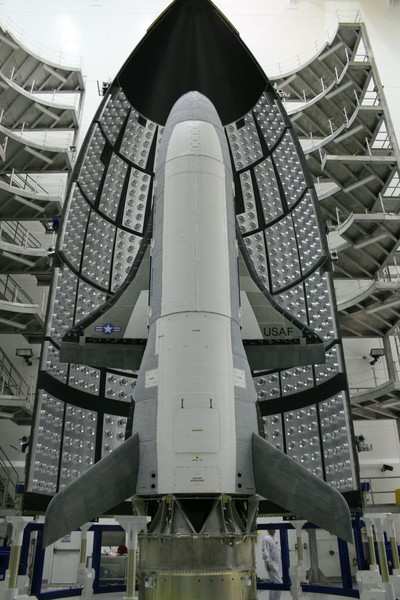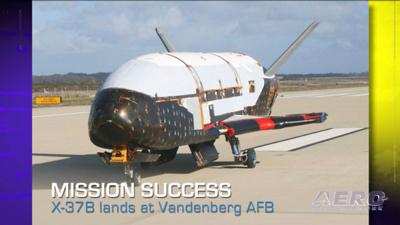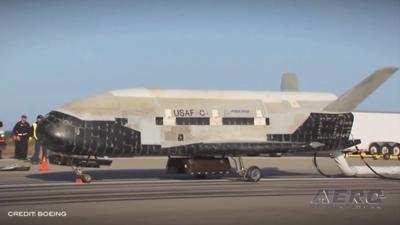The Collier Trophy Has Been Awarded Annually Since 1911
The Department of the Air Force’s X-37B spaceplane, a reusable, multi-purpose, system that operates without an onboard crew, won the prestigious Robert J. Collier Trophy Aug. 13 for advancing technology that pushes “the boundaries of flight and space exploration.”

In announcing the award, Jim Albaugh, chairman of The National Aeronautic Association which sponsors the competition, praised the X-37B, “As the world’s only autonomous, reusable spaceplane, it continues to contribute to our understanding of both space and air flight.”
The Collier Trophy has been awarded annually since 1911 and is one of the most prominent accolades in aviation. Previous winners include Orville Wright, Howard Hughes, as well as the Apollo 11 lunar landing team, Apollo 8, Mercury 7 and more recently, the International Space Station. Also earning the distinction are the B-52, the Boeing 747 and the F-22, among others.
“Underscoring the importance of space to the nation, the Collier Trophy celebrates the record-setting mission of the X-37B,” Secretary of the Air Force Barbara Barrett said. “Most Americans use space daily for navigation, information, and communication. Sophisticated and uncrewed, the X-37B advances reusable spaceplane technologies and operates experiments in space that are returned for further examination on earth.”
The X-37B prevailed over a diverse group of nine finalists that included the latest iteration of the Airborne Collision Avoidance System team or ACAS credited with “reducing the risk of midair aircraft collisions and close calls.”
Other nominees included the updated Hubble Space Telescope that allows scientists “to explore the universe in ways that no single mission could ever accomplish alone,” and Project Heaviside, “a high-performance electric vertical-takeoff-and-landing vehicle” that could eventually “free people from traffic.”
Technologies and products also considered for the 2019 Collier included the Bombardier Global 7500 and the Gulfstream G500 and G600 business jets offering range, seating capacity and performance that “transformed business aviation.” Still another finalist was the magni500 electric propulsion system, a series of high-power-density electric motors designed to move aircraft cleanly and efficiently.

While the trophy reflects the work and innovation of teams across the Department of the Air Force, it is especially significant for the nascent U.S. Space Force, the first new branch of the military since 1947 that was created in December 2019.
The X-37B provides the Department of the Air Force the ability to conduct experiments and perform other functions in earth orbit.
“The X-37B team win of the 2019 National Aeronautic Association, Robert J. Collier Trophy exemplifies the kind of lean, agile and innovative technological development our nation needs to secure its interests," said Gen. John “Jay” Raymond, U.S. Space Force Chief of Space Operations.
"The ability to test new systems in space and return them to Earth is unique to the X-37B and enables the U.S. to more efficiently and effectively develop space power to maintain superiority in the space domain," Raymond said.
Air Force Chief of Staff, Gen. Charles Q. Brown, Jr., also praised the selection.

"The X-37 is a successful example of integrated operations between the Air Force, Space Force, and government-industry partnerships," Brown said. "Reusable space vehicle technologies are a significant contributor to accelerating capabilities for the Department of Defense and the nation."
In all, the spaceplane has flown six missions since being launched for the first time on April 22, 2010.
In 2019 the X-37B set a new 780-day on-orbit endurance record and completed an overflight of the United States, using Federal Aviation Administration airspace, before landing at NASA’s Kennedy Space Center. That mission broke the previous on-orbit record of 718 days that also was held by the X-37B.
In all, the program has logged more than 2,865 days and travelled more than 1 billion miles on orbit.
 Airborne 04.16.24: RV Update, Affordable Flying Expo, Diamond Lil
Airborne 04.16.24: RV Update, Affordable Flying Expo, Diamond Lil ANN's Daily Aero-Term (04.20.24): Light Gun
ANN's Daily Aero-Term (04.20.24): Light Gun Aero-News: Quote of the Day (04.20.24)
Aero-News: Quote of the Day (04.20.24) Aero-News: Quote of the Day (04.21.24)
Aero-News: Quote of the Day (04.21.24) ANN's Daily Aero-Term (04.21.24): Aircraft Conflict
ANN's Daily Aero-Term (04.21.24): Aircraft Conflict





